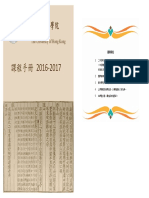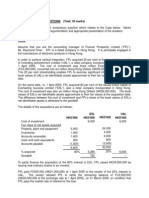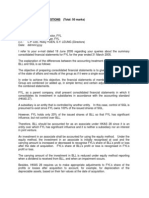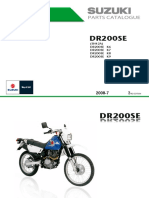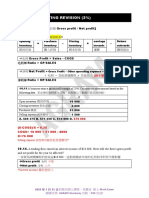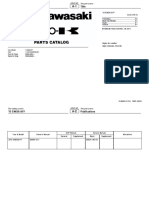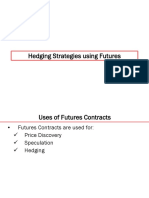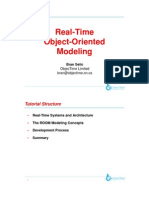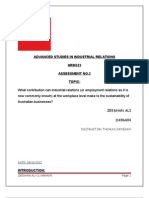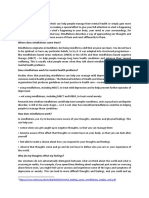HKICPA QP Exam (Module A) Feb2008 Question Paper
HKICPA QP Exam (Module A) Feb2008 Question Paper
Uploaded by
cynthia tsuiCopyright:
Available Formats
HKICPA QP Exam (Module A) Feb2008 Question Paper
HKICPA QP Exam (Module A) Feb2008 Question Paper
Uploaded by
cynthia tsuiOriginal Description:
Original Title
Copyright
Available Formats
Share this document
Did you find this document useful?
Is this content inappropriate?
Copyright:
Available Formats
HKICPA QP Exam (Module A) Feb2008 Question Paper
HKICPA QP Exam (Module A) Feb2008 Question Paper
Uploaded by
cynthia tsuiCopyright:
Available Formats
SECTION A – CASE QUESTIONS (Total: 50 marks)
Answer the following ONE compulsory question which relates to the Case below. Marks will be
awarded for logical argumentation and appropriate presentation of the answers.
CASE
Assume that you are Ms. Pindy Lee, the accounting manager of Most Capital Limited (“MCL”).
MCL is a company incorporated and listed in Hong Kong and is principally engaged in the
manufacturing of sanitary ware.
As at 1 April 2007, MCL had two subsidiaries, First Successful Limited (“FSL”) and Second
Winning Limited (“SWL”). A summary of the acquisitions of these subsidiaries by MCL is as
follows:
Retained
Date of % Cost of earnings at Net assets at
acquisition acquired investment acquisition date acquisition date
HK$'000 HK$'000 HK$'000
FSL 31 March 2006 70 20,000 15,000 25,000
SWL 31 March 2006 60 10,000 7,000 15,000
The fair value of the identifiable net assets of these subsidiaries at the respective date of
acquisition was the same as the carrying amount of those assets.
The retained earnings of MCL, FSL and SWL, as at 31 March 2007, were $32 million,
$20 million and $8 million respectively. The companies did not have any reserves other than
retained earnings. The details of the issued share capital of MCL, FSL and SWL as at 31
March 2007 are as follows:
Issued Number of Par value
capital shares per share
HK$ million million HK$
MCL 60 10 6
FSL 10 5 2
SWL 8 8 1
MCL made a rights issue of one share for every two ordinary shares that was fully exercised on
1 January 2008. The exercise price was $9 per share and the fair value of one ordinary share
of MCL immediately before the rights issue was $12. The issued share capital of FSL and SWL
has not changed since their acquisition by MCL.
Module A (February 2008 Session) Page 1 of 8
The following table summarises information from the three companies’ income statements for the
year ended 31 March 2008:
MCL FSL SWL
HK$'000 HK$'000 HK$'000
Turnover 300,000 140,000 72,500
Cost of sales (243,000) (112,000) (58,000)
Gross profit 57,000 28,000 14,500
Distribution costs (15,000) (7,500) (4,000)
Administrative expenses (10,000) (5,000) (2,500)
Depreciation and amortisation (3,000) (1,500) (1,000)
Profit from operations 29,000 14,000 7,000
Finance costs (4,000) (2,000) (1,000)
Profit before tax 25,000 12,000 6,000
Tax (7,000) (5,000) (2,000)
Profit for the year 18,000 7,000 4,000
On 30 September 2007, MCL sold 2.4 million shares in SWL for $8 million. The gain on this
disposal has not been included in the above income statements.
On 31 March 2008, MCL sold all its plant and equipment, with an original purchase cost of $20
million and a carrying amount of $12 million, to a bank for its fair value of $16 million cash.
MCL then leased the plant and equipment back from the bank under a finance lease over four
years. The lease arrangement called for annual year-end payments of
$1.6 million. At the end of the lease term, the bank is obligated to return the plant and
equipment to MCL at an amount that has the overall effect, taking into account the lease
payments, of providing the bank with a yield of the best lending rate minus 1% per annum. The
remaining useful lives of the plant and equipment at 31 March 2008 ranged from 8 to 10 years.
No entries relating to the disposal have been recorded by MCL and the group.
During the year ended 31 March 2008, FSL sold goods to MCL at an invoiced value of
$1 million. FSL usually sold goods at cost plus 25%. Half of the goods were still held in MCL’s
inventory at 31 March 2008.
MCL has adopted an accounting policy which depreciates plant and equipment using the
straight-line method over a 10-year life with no residual value. It is also the group’s policy that
interests in subsidiaries and associates are carried at cost in the separate financial statements.
SWL’s results for the six months ended 30 September 2007 were exactly half of its annual
results in the year ended 31 March 2008.
Module A (February 2008 Session) Page 2 of 8
You have then added the gain on disposal of investment in SWL into MCL’s financial statements
and prepared draft consolidated financial statements of MCL for the year ended 31 March 2008.
After you sent these draft consolidated financial statements to MCL’s directors for review, one of
the directors, who is not a certified public accountant, sent you an e-mail as follows:
To: Pindy LEE, Accounting Manager, MCL
From: Faria LEE (Director)
c.c.: Beverly CHOW, Emily WILSCON, Charmaine YUEN (Directors)
Date: 18 May 2008
Consolidated financial statements of MCL as at 31 March 2008
Could you please clarify the following points relating to MCL’s draft consolidated financial
statements which I have just reviewed.
(A) So far as I understand, we have already disposed of all our plant and equipment. I am
not aware that we have purchased any new plant and equipment. Why is there still an
amount of HK$12 million of plant and equipment in the consolidated balance sheet?
(B) I find two new items, namely an “Investment in an associate” in the consolidated balance
sheet and a “Share of profit of an associate” in the consolidated income statement for the
year ended 31 March 2008. Why are these items with the consolidated financial
statements?
(C) I note that the amount of gain on disposal of our investment in SWL as shown in our
separate income statement and that in the consolidated income statement are different.
Why is there such a difference?
(D) I note that MCL made a rights issue during the year. Will this have any impact on its
EPS of MCL for the year?
I would appreciate your clarification in time for the upcoming board meeting.
Best regards,
Faria
Module A (February 2008 Session) Page 3 of 8
Required:
Question 1 (50 marks – approximately 90 minutes)
(a) Prepare a memorandum in response to the issues raised by Ms. Faria LEE. In your
memorandum, you should:
(i) discuss the reasons for the amount of HK$12 million of plant and equipment
as shown in the consolidated balance sheet;
(5 marks)
(ii) discuss how MCL should account for its interest in SWL before and after the
disposal of the 2.4 million shares in SWL (no computation is expected in this
part);
(10 marks)
(iii) discuss why the amount of the gain on disposal of the investment in SWL as
shown in the separate income statement and in the consolidated income
statement is different; and
(5 marks)
(iv) discuss with appropriate calculation, the impact of the rights issue on the
earnings per share of MCL for the year ended 31 March 2008.
(10 marks)
(b) Prepare an annex to your memorandum showing the consolidated income statement
for the year ended 31 March 2008. (Journal entries are not required.) Ignore
deferred taxation.
(20 marks)
* * * END OF SECTION A * * *
Module A (February 2008 Session) Page 4 of 8
SECTION B – ESSAY / SHORT QUESTIONS (Total: 50 marks)
Answer ALL of the following questions. Marks will be awarded for logical argumentation and
appropriate presentation of the answers.
Question 2 (10 marks – approximately 18 minutes)
(a) Explain the differences between the Hong Kong Financial Reporting Standards and
the Accounting Guidelines issued by the Hong Kong Institute of Certified Public
Accountants.
(5 marks)
(b) Explain how materiality (and immateriality) is related to the relevance of the financial
statements.
(5 marks)
Module A (February 2008 Session) Page 5 of 8
Question 3 (12 marks – approximately 22 minutes)
Bestpoint Printing Limited (“BP”), established in the People’s Republic of China (“PRC”), is a
wholly-owned subsidiary of Glory Publishing Group (“GP”). BP is entitled to a two-year
exemption from foreign enterprise income tax (“FEIT”) from its first profit-making year, as
computed under PRC accounting standards (“PRC GAAP”) and tax regulations. For the
following three years, it enjoyed a 50% reduction in the rate of FEIT. 2003 was BP’s first
profit-making year. The standard tax rate for BP was 24% for the periods up to
31 December 2007. With the enactment of the new tax law during 2007, BP will be subject to
FEIT at 25% for the year beginning 1 January 2008. GP is subject to Hong Kong Profits Tax at
17.5%.
BP acquired a printing machine on 1 July 2003 at a cost of HK$20 million. For the purpose of
FEIT calculations, the machine is depreciated over 10 years with a residual value of 10% of the
cost from the corresponding date of acquisition, which is the same for the preparation of BP’s
PRC GAAP financial statements. In the preparation of GP’s consolidated financial statements,
the machine is depreciated over 16 years with nil residual value.
Required:
(a) Calculate the deferred tax asset or liability position in relation to the machine at 31
December 2007 accounted for in GP’s consolidated financial statements.
(5 marks)
(b) Prepare the journal entry(ies) to record the deferred income taxes at
31 December 2008 for GP's consolidated financial statements with calculation
supporting the balances recorded.
(5 marks)
(c) Assuming GP has a deferred tax asset of HK$500,000 in respect of its own plant and
equipment at 31 December 2008, explain how the deferred taxes will appear on the
consolidated balance sheet at that date.
(2 marks)
Module A (February 2008 Session) Page 6 of 8
Question 4 (15 marks – approximately 27 minutes)
Cliff Land Limited (“CLL”) owns the following three buildings in Hong Kong:
Building A Building B Building C
Usage Warehouse Director’s Earning rental
quarter income
Date of acquisition 1 January 2000 1 January 1998 1 January 2005
Cost of the building HK$20 million HK$36 million HK$18 million
Fair value of the building at HK$28 million HK$22 million HK$22 million
31 December 2007
In the board meeting held on 30 September 2007, the management of CLL determined to sell
Buildings B and C. A property agency was appointed in the following month to identify potential
buyers. In addition, CLL moved the storage of its inventories in Building A to a new production
plant in Shenzhen. At 31 December 2007, all three buildings were vacant.
CLL has accounted for (i) the building under property, plant and equipment at cost basis and
depreciated the cost with the estimated useful life of 30 years, (ii) the investment property at fair
value model, and (iii) the land cost as operating lease under HKAS 17. Cost and fair value of
the land are assumed to be zero. Cost to sell the buildings is estimated at 0.5% of the disposal
value of the asset.
Required:
Determine the balance sheet classification of these three buildings and calculate the
respective amounts to be recognised on the balance sheet as at 31 December 2007.
(15 marks)
Module A (February 2008 Session) Page 7 of 8
Question 5 (13 marks – approximately 23 minutes)
Darren Company Limited (“DCL”) is engaged in the manufacture of batteries. On the unaudited
balance sheet as at 30 June 2008, it has recognised the following provisions as current
liabilities:
(a) A provision for late delivery penalty
In May 2008, DCL received a sales order for 7,000,000 units of rechargeable batteries for
which the agreed delivery date is 31 August 2008. It is expected that DCL would earn a
gross profit of HK$1 per unit. Due to a shortage in the supply of raw materials, at the
balance sheet date, the management realised that they could only supply the goods at the
earliest on 10 September 2008. According to the sales contract, DCL would compensate
the customer for late delivery at HK$0.01 per unit per day.
(b) A provision for annual safety inspection of the production line
The last inspection was carried out in June 2007. Due to a large backlog of sales orders,
the management decided to postpone the annual inspection until mid-September 2008.
(c) A provision for the loss on sales of aged finished goods
The products were manufactured in late 2006 with an expected normal usage period of 2
years from the date of production. Due to the short expiry period, they were sold at a
price below cost in July 2008.
(d) A provision for bonus payments to two executive directors
In accordance with the directors’ service contract, two executive directors are entitled to
receive, in addition to monthly salaries, a bonus of equivalent to 5% of the profit before
taxation and the accrued bonus.
Required:
Discuss the appropriateness of the provisions recognised by DCL.
(13 marks)
* * * END OF EXAMINATION PAPER * * *
Module A (February 2008 Session) Page 8 of 8
You might also like
- Weixin Official Account Registration and Verification Application FormDocument1 pageWeixin Official Account Registration and Verification Application Form叶桂清No ratings yet
- Sample Midterm For Risk Management (MGFD30)Document21 pagesSample Midterm For Risk Management (MGFD30)somebodyNo ratings yet
- Dialogue I: Talking About Hobbies: Integrated ChineseDocument9 pagesDialogue I: Talking About Hobbies: Integrated ChineseSebastian ZNo ratings yet
- HKICPA QP Exam (Module A) May2007 AnswerDocument13 pagesHKICPA QP Exam (Module A) May2007 Answercynthia tsuiNo ratings yet
- HKU School of Chinese 2016 - 17 - Handbook PDFDocument114 pagesHKU School of Chinese 2016 - 17 - Handbook PDFlccslccs200100% (1)
- HKICPA QP Exam (Module A) May2007 AnswerDocument13 pagesHKICPA QP Exam (Module A) May2007 Answercynthia tsuiNo ratings yet
- HKICPA QP Exam (Module A) May2007 AnswerDocument13 pagesHKICPA QP Exam (Module A) May2007 Answercynthia tsuiNo ratings yet
- HKICPA QP Exam (Module A) Sep2006 Question PaperDocument7 pagesHKICPA QP Exam (Module A) Sep2006 Question Papercynthia tsuiNo ratings yet
- HKICPA QP Exam (Module A) Feb2006 Question PaperDocument7 pagesHKICPA QP Exam (Module A) Feb2006 Question Papercynthia tsuiNo ratings yet
- HKICPA QP Exam (Module A) May2007 Question PaperDocument7 pagesHKICPA QP Exam (Module A) May2007 Question Papercynthia tsuiNo ratings yet
- HKICPA QP Exam (Module A) May2005 AnswerDocument12 pagesHKICPA QP Exam (Module A) May2005 Answercynthia tsuiNo ratings yet
- HKICPA QP Exam (Module A) Feb2008 AnswerDocument10 pagesHKICPA QP Exam (Module A) Feb2008 Answercynthia tsui100% (1)
- HKICPA QP Exam (Module A) Sep2004 AnswerDocument14 pagesHKICPA QP Exam (Module A) Sep2004 Answercynthia tsuiNo ratings yet
- HKICPA QP Exam (Module A) May2005 Question PaperDocument6 pagesHKICPA QP Exam (Module A) May2005 Question Papercynthia tsuiNo ratings yet
- HKICPA QP Exam (Module A) Sep2004 Question PaperDocument7 pagesHKICPA QP Exam (Module A) Sep2004 Question Papercynthia tsuiNo ratings yet
- HKICPA QP Exam (Module A) Sep2008 AnswerDocument12 pagesHKICPA QP Exam (Module A) Sep2008 Answercynthia tsuiNo ratings yet
- HKICPA QP Exam (Module A) Sep2008 Question PaperDocument9 pagesHKICPA QP Exam (Module A) Sep2008 Question Papercynthia tsui67% (3)
- HKICPA QP Exam (Module A) Sep2006 AnswerDocument15 pagesHKICPA QP Exam (Module A) Sep2006 Answercynthia tsui100% (2)
- HKICPA QP Exam (Module A) Feb2006 AnswerDocument12 pagesHKICPA QP Exam (Module A) Feb2006 Answercynthia tsuiNo ratings yet
- Honda Air Blade 110 Fi - Service Manual-299Document407 pagesHonda Air Blade 110 Fi - Service Manual-299newlife56812024No ratings yet
- Sv650k8e3 PDFDocument128 pagesSv650k8e3 PDFAdolfoNo ratings yet
- Berk DeMarzo cf5 PPT 11 AccessibleDocument140 pagesBerk DeMarzo cf5 PPT 11 Accessibleshehry .CNo ratings yet
- 會計學專有名詞Document15 pages會計學專有名詞張予璨100% (4)
- DR200SE: Parts CatalogueDocument78 pagesDR200SE: Parts CatalogueOrlando AcostaNo ratings yet
- 2020_Ninja 1000SX_ZXT02KLFSE_21091125Document109 pages2020_Ninja 1000SX_ZXT02KLFSE_21091125enguscjsNo ratings yet
- Listening Summary For Oet 2.0Document410 pagesListening Summary For Oet 2.0aazaninnocentNo ratings yet
- Offer帮 Resume Verb ListDocument4 pagesOffer帮 Resume Verb ListZeng ChengNo ratings yet
- Using Articles in Medical Writing: The Spleen Is An Organ That Plays ADocument2 pagesUsing Articles in Medical Writing: The Spleen Is An Organ That Plays AHeba ZaherNo ratings yet
- 2CEXAM Mock Question Licensing Examination Paper 8Document9 pages2CEXAM Mock Question Licensing Examination Paper 8Tsz Ngong KoNo ratings yet
- sfv650 - Gladius - l3 E99Document89 pagessfv650 - Gladius - l3 E99Cesar SalasNo ratings yet
- PARTES GSF650k8 PDFDocument128 pagesPARTES GSF650k8 PDFAdolfoNo ratings yet
- All Days NotesDocument11 pagesAll Days NotesAkshit SharmaNo ratings yet
- Massachusetts Eviction NoticeDocument1 pageMassachusetts Eviction NoticeRocketLawyerNo ratings yet
- 国际音标讲义Document42 pages国际音标讲义曹奇永No ratings yet
- BA CH3 會計算式 (GP - NP)Document2 pagesBA CH3 會計算式 (GP - NP)Chun Kit LauNo ratings yet
- Future Land TemplatesDocument3 pagesFuture Land TemplatesEsra MustafaNo ratings yet
- DR200SEK5Document114 pagesDR200SEK5fernandoNo ratings yet
- Macroeconomics, ECON 2123: MC Practice SolutionsDocument29 pagesMacroeconomics, ECON 2123: MC Practice Solutionsbwing yoNo ratings yet
- Junos Release Notes 22.4r3Document177 pagesJunos Release Notes 22.4r3janiszwNo ratings yet
- EN650AFFPH Vulcan S (2015) PDFDocument102 pagesEN650AFFPH Vulcan S (2015) PDFAlbert DepanoNo ratings yet
- 16Document23 pages16Alex liao0% (1)
- Stomach CADocument4 pagesStomach CAJordanHayesNo ratings yet
- Ps1 EF4331 - Revised Answer)Document9 pagesPs1 EF4331 - Revised Answer)Jason YP KwokNo ratings yet
- Suzuki Boulevard L6Document92 pagesSuzuki Boulevard L6GRANNo ratings yet
- EnglishDocument5 pagesEnglishAndreea1794No ratings yet
- 4 - Hedging Strategies Using Futures PDFDocument74 pages4 - Hedging Strategies Using Futures PDFsiddhant singhNo ratings yet
- CH 08 Hull Fundamentals 8 The DDocument13 pagesCH 08 Hull Fundamentals 8 The DjlosamNo ratings yet
- Singapore Institute of Management: Instructions To CandidatesDocument20 pagesSingapore Institute of Management: Instructions To CandidatesmaccheeseNo ratings yet
- ACCA SBR MJ19 Notes PDFDocument150 pagesACCA SBR MJ19 Notes PDFSuniel JamilNo ratings yet
- Derivatives - Betting: Chapter Break UpDocument34 pagesDerivatives - Betting: Chapter Break UpJatinkatrodiyaNo ratings yet
- V2 Exam 2 PM PDFDocument30 pagesV2 Exam 2 PM PDFMaharishi VaidyaNo ratings yet
- Catalogo de Partes KLX150Document105 pagesCatalogo de Partes KLX150Sergio Molina100% (1)
- Reading 9 Employee Compensation - Post-Employment and Share-Based - AnswersDocument21 pagesReading 9 Employee Compensation - Post-Employment and Share-Based - Answerstristan.riolsNo ratings yet
- Gotham City Research LLC: Page 1 of 4Document4 pagesGotham City Research LLC: Page 1 of 4gothamcityresearchNo ratings yet
- Cleared Swap Handbook: Derivative Processing Under The Dodd-Frank Act and European Market Infrastructure Reform (Emir)Document16 pagesCleared Swap Handbook: Derivative Processing Under The Dodd-Frank Act and European Market Infrastructure Reform (Emir)senapatiabhijitNo ratings yet
- Parts Catalogue: '19 ER300 AKF/AKFA (CL) (Z300)Document87 pagesParts Catalogue: '19 ER300 AKF/AKFA (CL) (Z300)Yeison Cartagena BedoyaNo ratings yet
- LX150JMFNN 2021Document73 pagesLX150JMFNN 2021chaxt strongNo ratings yet
- ANSWERS Second Term Sheet Mar2022Document2 pagesANSWERS Second Term Sheet Mar2022AvinashSinghNo ratings yet
- MSX125 - 1 - General Information - 3Document26 pagesMSX125 - 1 - General Information - 3camu233No ratings yet
- F2 Questions November 2010Document20 pagesF2 Questions November 2010Robert MunyaradziNo ratings yet
- AFIN215FPD1520172Document20 pagesAFIN215FPD1520172matem8092No ratings yet
- F2 March 2011Document20 pagesF2 March 2011Dhanushka SamNo ratings yet
- HKICPA QP Exam (Module A) Sep2008 AnswerDocument12 pagesHKICPA QP Exam (Module A) Sep2008 Answercynthia tsuiNo ratings yet
- HKICPA QP Exam (Module A) Sep2006 AnswerDocument15 pagesHKICPA QP Exam (Module A) Sep2006 Answercynthia tsui100% (2)
- HKICPA QP Exam (Module A) Sep2004 AnswerDocument14 pagesHKICPA QP Exam (Module A) Sep2004 Answercynthia tsuiNo ratings yet
- HKICPA QP Exam (Module A) Feb2006 AnswerDocument12 pagesHKICPA QP Exam (Module A) Feb2006 Answercynthia tsuiNo ratings yet
- HKICPA QP Exam (Module A) Sep2004 Question PaperDocument7 pagesHKICPA QP Exam (Module A) Sep2004 Question Papercynthia tsuiNo ratings yet
- HKICPA QP Exam (Module A) Sep2008 Question PaperDocument9 pagesHKICPA QP Exam (Module A) Sep2008 Question Papercynthia tsui67% (3)
- HKICPA QP Exam (Module A) May2005 Question PaperDocument6 pagesHKICPA QP Exam (Module A) May2005 Question Papercynthia tsuiNo ratings yet
- Real-Time Object-Oriented Modeling: Tutorial StructureDocument27 pagesReal-Time Object-Oriented Modeling: Tutorial StructureSatyender YadavNo ratings yet
- Englishfor Studentsof EconomicsDocument22 pagesEnglishfor Studentsof EconomicsMezed 91No ratings yet
- Parliamentarian - Crisis of Justice - Rise and Fall of The Indian Judicial SystemDocument92 pagesParliamentarian - Crisis of Justice - Rise and Fall of The Indian Judicial SystemEllie chopraNo ratings yet
- How Do SMEs Decide On International Market Entry - An Empirical Examination in The Middle EastDocument18 pagesHow Do SMEs Decide On International Market Entry - An Empirical Examination in The Middle EastSri NarendiranNo ratings yet
- Cherokee and West Africa - Origins of The Vai ScriptDocument61 pagesCherokee and West Africa - Origins of The Vai ScriptLazaf KilamNo ratings yet
- Daftar Penumpang Kereta API Indonesia (PP)Document8 pagesDaftar Penumpang Kereta API Indonesia (PP)MIHI MentoroNo ratings yet
- Delta Copy ManualDocument20 pagesDelta Copy ManualJose OnzoNo ratings yet
- Coconut Lecture PresentationDocument49 pagesCoconut Lecture PresentationAmoako DerrickNo ratings yet
- ANSI - IEC61850 - Eng ABB PDFDocument68 pagesANSI - IEC61850 - Eng ABB PDFmukesh2512No ratings yet
- CIA Summary-USADocument1 pageCIA Summary-USAAnshumaan SinghNo ratings yet
- Alles Mit Gott Und Nichts Ohn' Ihn: Continuo (Cembalo)Document3 pagesAlles Mit Gott Und Nichts Ohn' Ihn: Continuo (Cembalo)charlzjin9700No ratings yet
- Psych Abnormal Child Psychology - 6th Edition (2015) - 350-400Document51 pagesPsych Abnormal Child Psychology - 6th Edition (2015) - 350-400tin_ally9059No ratings yet
- Unit 3 Project ProposalDocument4 pagesUnit 3 Project ProposalJWSolberg18No ratings yet
- Industrial AssignmentDocument14 pagesIndustrial AssignmentzeeshanNo ratings yet
- Pitb Data Staff MFDDocument4 pagesPitb Data Staff MFDhcmltnfdNo ratings yet
- MindfulnessDocument2 pagesMindfulnessSarvagya JhaNo ratings yet
- SFAC - Value Chain Analysis Pages 91 96Document6 pagesSFAC - Value Chain Analysis Pages 91 96shubhram2014No ratings yet
- Module 5 ExamDocument6 pagesModule 5 ExamSftts TagapagsanayNo ratings yet
- Surface - PreparationDocument102 pagesSurface - PreparationQudri SaufiNo ratings yet
- Social Media Press Release - Eric Church - Spring 2019 - Cheyenne MolnarDocument4 pagesSocial Media Press Release - Eric Church - Spring 2019 - Cheyenne Molnarapi-535098194No ratings yet
- Issue of SharesDocument3 pagesIssue of SharesPratiksha PatelNo ratings yet
- EUROLAB Cook Book - Doc No 18 Risk Based Appraoch - Rev. 2017Document5 pagesEUROLAB Cook Book - Doc No 18 Risk Based Appraoch - Rev. 2017Anonymous Z7Lx7q0Rz100% (1)
- Hyperloop Report PDF Seminar ReportDocument21 pagesHyperloop Report PDF Seminar ReportSaurabhNo ratings yet
- DocumentationDocument48 pagesDocumentationstchatzNo ratings yet
- Statics: Vector Mechanics For EngineersDocument39 pagesStatics: Vector Mechanics For EngineersArdaNo ratings yet
- Ma'Am Rowena Abat Module in Monetary PolicyDocument57 pagesMa'Am Rowena Abat Module in Monetary PolicyFrancisco, Mariell M.No ratings yet
- Oxidation Stability of Insulating FluidsDocument79 pagesOxidation Stability of Insulating FluidsJicheng PiaoNo ratings yet
- Fly High My BirdDocument6 pagesFly High My BirdtanNo ratings yet
- Safety and Security Shutdown ChecklistDocument3 pagesSafety and Security Shutdown Checklistakunkuis2023No ratings yet
- 2nd Task - Rianti Pratiwi - Review of 7 Articles Using 17 StandardsDocument22 pages2nd Task - Rianti Pratiwi - Review of 7 Articles Using 17 Standardsrianti pratiwiNo ratings yet




